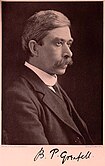Papyrus 22
| New Testament manuscript | |
 | |
| Name | P. Oxy. 1228 |
|---|---|
| Text | John 15-16 † |
| Date | 3rd century |
| Script | Greek |
| Found | Egypt |
| Now at | Glasgow University Library |
| Cite | B. P. Grenfell & A. S. Hunt, Oxyrynchus Papyri’' X, (London 1914), pp. 14-16 |
| Size | 18.5 x 5 cm |
| Type | Alexandrian text-type |
| Category | I |
Papyrus 22, designated by 𝔓22 (in the Gregory-Aland numbering of New Testament manuscripts), is an early copy of the New Testament in Greek. It is a papyrus manuscript of the Gospel of John, only containing extant John 15:25-16:2, 21–32. Using the study of comparative writings styles, (palaeography), the manuscript has been dated to the early 3rd century CE.[1] It is the only identified New Testament papyrus to have been written originally as a roll; not a codex or re-using the back of a scroll.
Description
The text was written in two consecutive columns on a roll. The reverse side is blank.[2] The manuscript employs conventional Nomina Sacra: ΠΣ ΠΝΑ ΠΡΣ ΠΡΑ ΙΗΣ ΑΝΟΣ. The text contains no punctuation marks.[3]
The Greek text of this codex is considered a representative of the Alexandrian text-type. Aland described it as a normal text and placed it in Category I.[1] This manuscript displays an independent text.[2] Coincidences with the Codex Sinaiticus are frequent, but divergences are noticeable.[3] There are no singular readings.[4] According to Schofield the fragment rather represents the eclecticism of the early papyri before the crystallizing of the textual families had taken place.[2]
It is currently housed at the Glasgow University Library (MS Gen 1026) in Glasgow.[1][5]
See also
References
- ^ a b c Aland, Kurt; Aland, Barbara (1995). The Text of the New Testament: An Introduction to the Critical Editions and to the Theory and Practice of Modern Textual Criticism. Erroll F. Rhodes (trans.). Grand Rapids: William B. Eerdmans Publishing Company. p. 97. ISBN 978-0-8028-4098-1.
- ^ a b c Comfort, Philip Wesley; David P. Barrett (2001). The Text of the Earliest New Testament Greek Manuscripts. Wheaton, Illinois: Tyndale House Publishers. p. 109. ISBN 978-0-8423-5265-9.
- ^ a b B. P. Grenfell & A. S. Hunt, Oxyrynchus Papyri X, (London 1914), p. 14.
- ^ Peter M. Head, The Habits of New Testament Copyists Singular Readings in the Early Fragmentary Papyri of John, Biblica 85 (2004), 406.
- ^ "Liste Handschriften". Münster: Institute for New Testament Textual Research. Retrieved 23 August 2011.
Further reading
- B. P. Grenfell & A. S. Hunt, Oxyrynchus Papyri X, (London 1914), pp. 14–16.


